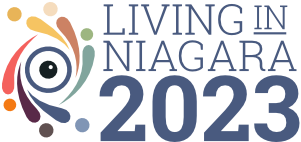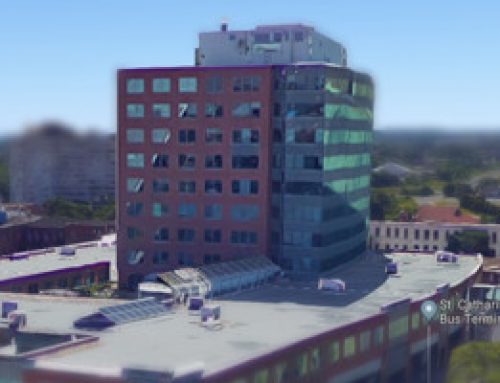Canada-US Border Crossings:
The following table shows the yearly traffic crossing the Peace Bridge between Fort Erie and Buffalo. Traffic is divided by direction and by type. More detailed data about traffic by month and year is available at the source listed. Data is updated monthly.
Source: The Peace Bridge.Historical Traffic Statistics.
Retrieved from http://www.peacebridge.com/index.php/historical-traffic-statistics/yearly-volumes
Note: Traffic volume statistics are not made publicly available for the Rainbow Bridge, the Queenston-Lewiston Bridge, or the Whirlpool Rapids Bridge.
To view current wait times for crossing the Canada – US border, visit the Canada Border Services Agency website at: http://www.cbsa-asfc.gc.ca/bwt-taf/
Daily Truck Trips and Movement of Goods:
The 2017 Niagara Region Transportation Master Plan (TMP) cites Niagara Region Travel Demand Model projections that the number of Daily Truck Trips in Niagara will increase by 57% between 2011 and 2041. The number of daily truck trips will go from 35,000 in 2011 to 55,000 in 2041. Of those 55,000 truck trips, 12,000 will be within the same local municipality; 22,000 will be between municipalities in Niagara; and 21,000 will be trucks travelling to/from external points outside of Niagara.
The August, 2016 Niagara Region TMP Needs and Opportunities Report points out that most freight moving across the U.S. border through the region simply passes through. The report state: “Cross-border truck volumes have dropped since 2001, but show signs of recovery and are expected to be higher in 2041. Steeply graded roads across the Niagara Escarpment and congestion on the Queen Elizabeth Way leading to the Greater Toronto and Hamilton Area (GTHA) are among the challenges to efficient goods movement in Niagara.”
Source: Niagara Region Transportation Master Plan Needs and Opportunities Report, August, 2016.
Retrieved from: https://www.niagararegion.ca/2041/pdf/tmp-needs-report.pdf
Road Congestion:
The table below indicates the number of times a vehicle travels over each lane kilometre of major road, demonstrating road congestion, for Niagara, three comparison municipalities (Halton, Hamilton, Toronto), and the median across 14 municipalities that report data on this measure.
| Vehicle Km Traveled per Lane Km, 2013-2015 | |||
| 2013 | 2014 | 2015 | |
| Niagara | 1,360,952 | 1,282,862 | 1,337,229 |
| Halton | 1,797,976 | 1,827,649 | 1,802,430 |
| Hamilton | 1,712,038 | 1,720,598 | 1,726,334 |
| Toronto | 2,193,428 | 2,192,307 | 2,186,344 |
| Median (14 municipalities) | 1,507,709 | 1,517,781 | 1,541,132 |
Source: Municipal Benchmarking Network Canada (2015).2015 Performance Measurement Report.
Retrieved from: http://www.niagaraknowledgeexchange.com/resources-publications/2015-performance-measurement-report/
Cost for Paved Roads:
The table below examines the total cost for paved roads per lane kilometre for Niagara and three comparison municipalities (Halton, Hamilton, Toronto).
| Total Cost for Paved Roads per Lane Km, 2013-2015 | |||
| 2013 | 2014 | 2015 | |
| Niagara | $9,249 | $9,097 | $9,352 |
| Halton | $19,485 | $19,851 | $23,467 |
| Hamilton | $12,187 | $12,521 | $10,743 |
| Toronto | $9,955 | $9,860 | $10,229 |
Source: Municipal Benchmarking Network Canada (2015).2015 Performance Measurement Report.
Retrieved from: http://www.niagaraknowledgeexchange.com/resources-publications/2015-performance-measurement-report/
Road Quality:
The table below shows the percent of paved lane kilometre where the condition is rated as good to very good for Niagara, three comparison municipalities (Halton, Hamilton, Toronto), and the median across 14 municipalities that report data on this measure.
| Percent of Paved Lane Km Rated as Good to Very Good, 2013-2015 | |||
| 2013 | 2014 | 2015 | |
| Niagara | 54% | 54% | 59% |
| Halton | 74% | 76% | 75% |
| Hamilton | 66% | 69% | 60% |
| Toronto | 80% | 78% | 79% |
| Median (14 municipalities) | 54% | 54% | 57% |
Source: Municipal Benchmarking Network Canada (2015). 2015 Performance Measurement Report.
Retrieved from: http://www.niagaraknowledgeexchange.com/resources-publications/2015-performance-measurement-report/
The St. Lawrence Seaway is the gateway to the heart of North America, and is considered to be one of the greatest engineering feats of all time. It is a deep draft waterway extending 3,700 km (2,340 miles) from the Atlantic Ocean to the head of the Great Lakes. Since opening in 1959, Seaway ships have moved over 2.75 billion tonnes of cargo worth about $400 billion. In Canada, The St. Lawrence Seaway Management Corporation (a not for profit) manages and operates the 13 Canadian locks, which extend from Montreal to mid-Lake Erie for the owner, the Government of Canada. In the U.S. a federal agency called the Saint Lawrence Seaway Development Corporation manages the Seaway’s 2 U.S. locks.
In Niagara, the Welland Canal portion of the system includes 8 locks that allow vessels to travel between Lake Ontario to the north and Lake Erie to the south. The poster at this link provides an overview of the system: http://www.greatlakes-seaway.com/en/pdf/SLS_PosterMay15.pdf . It points out that cargo moving on the Great Lakes/St. Lawrence Seaway supports $35 billion in economic activity; 227, 000 jobs; and $14.6 billion in wages.
Source: Great Lakes St. Lawrence Seaway System
Retrieved from: http://www.greatlakes-seaway.com/en/seaway/index.html
The Trillium Railway Company is a Niagara-based train system that transports people and freight through Port Colborne, Welland, Thorold, and St. Catharines, on the Port Colborne Harbour Railway.
Source: Trillium Railway Company
Retrieved from: http://www.trilliumrailway.com/
On February 8, 2016, St. Catharines City Council unanimously passed a motion to request VIA Rail and the Federal Government to restore effective VIA train service in Niagara. VIA service was removed in October, 2012.
Source: City of St. Catharines Council Meeting Minutes, February 8, 2016
Retrieved from: https://stcatharines.civicweb.net/filepro/documents/32691?preview=34767









